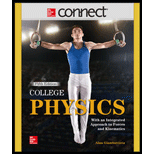
(a)
The radial acceleration of an object at the equator.
(a)
Answer to Problem 91P
The radial acceleration of an object at the equator is
Explanation of Solution
Write the expression for the acceleration.
Here,
Write the expression for
Here,
Use equation (II) in (I) to solve for
Conclusion:
Substitute
Therefore, the radial acceleration of an object at the equator is
(b)
Whether the object’s apparent weight greater or lesser than its weight.
(b)
Answer to Problem 91P
The apparent weight of the object is less than the weight of the object.
Explanation of Solution
Write the expression for the apparent weight of the object.
Here,
Write the expression for the actual weight of the object.
Here,
Since the obtained value for the radial acceleration is less than the gravitational field strength
Conclusion:
Therefore, the apparent weight of the object is less than the weight of the object.
(c)
The percentage of apparent weight differ from the weight at the equator.
(c)
Answer to Problem 91P
The percentage of apparent weight differ from the weight at the equator is
Explanation of Solution
Write the expression for the percentage of apparent weight differ from the weight at the equator.
Use equation (IV) and (V) in (VI) to solve for percentage of apparent weight differ from the weight at the equator.
Conclusion:
Substitute
Therefore, the percentage of apparent weight differ from the weight at the equator is
(d)
Whether the object’s apparent weight and the actual weight readings are equal on any place on earth.
(d)
Answer to Problem 91P
The object’s apparent weight and the actual weight readings are equal on the poles of the earth.
Explanation of Solution
The position on the earth where the object’s apparent weight and the actual weight are equal, the ratio of radial acceleration to the force of gravity is unity.
The poles of the earth, north pole and the south pole have the same radial acceleration and the force of gravity. As a result, the object’s apparent weight and the actual weight readings are equal on the poles of the earth.
Conclusion:
Therefore, the object’s apparent weight and the actual weight readings are equal on the poles of the earth.
Want to see more full solutions like this?
Chapter 5 Solutions
COLLEGE PHYSICS-CONNECT ACCESS
- Mick and Rick are twins born on Earth in the year 2175. Rick grows up to be an Earth-bound robotics technician while Mick becomes an intergalactic astronaut. Mick leaves the Earth on his first space mission in the year 2200 and travels, according to his clock, for 10 years at a speed of 0.75c. Unfortunately, at this point in his journey, the structure of his ship undergoes mechanical breakdown and the ship explodes. How old is Rick when his brother dies?arrow_forwardHi, I have canceled, why did you charge me again?arrow_forwardNo chatgpt pls will upvotearrow_forward
 College PhysicsPhysicsISBN:9781305952300Author:Raymond A. Serway, Chris VuillePublisher:Cengage Learning
College PhysicsPhysicsISBN:9781305952300Author:Raymond A. Serway, Chris VuillePublisher:Cengage Learning University Physics (14th Edition)PhysicsISBN:9780133969290Author:Hugh D. Young, Roger A. FreedmanPublisher:PEARSON
University Physics (14th Edition)PhysicsISBN:9780133969290Author:Hugh D. Young, Roger A. FreedmanPublisher:PEARSON Introduction To Quantum MechanicsPhysicsISBN:9781107189638Author:Griffiths, David J., Schroeter, Darrell F.Publisher:Cambridge University Press
Introduction To Quantum MechanicsPhysicsISBN:9781107189638Author:Griffiths, David J., Schroeter, Darrell F.Publisher:Cambridge University Press Physics for Scientists and EngineersPhysicsISBN:9781337553278Author:Raymond A. Serway, John W. JewettPublisher:Cengage Learning
Physics for Scientists and EngineersPhysicsISBN:9781337553278Author:Raymond A. Serway, John W. JewettPublisher:Cengage Learning Lecture- Tutorials for Introductory AstronomyPhysicsISBN:9780321820464Author:Edward E. Prather, Tim P. Slater, Jeff P. Adams, Gina BrissendenPublisher:Addison-Wesley
Lecture- Tutorials for Introductory AstronomyPhysicsISBN:9780321820464Author:Edward E. Prather, Tim P. Slater, Jeff P. Adams, Gina BrissendenPublisher:Addison-Wesley College Physics: A Strategic Approach (4th Editio...PhysicsISBN:9780134609034Author:Randall D. Knight (Professor Emeritus), Brian Jones, Stuart FieldPublisher:PEARSON
College Physics: A Strategic Approach (4th Editio...PhysicsISBN:9780134609034Author:Randall D. Knight (Professor Emeritus), Brian Jones, Stuart FieldPublisher:PEARSON





